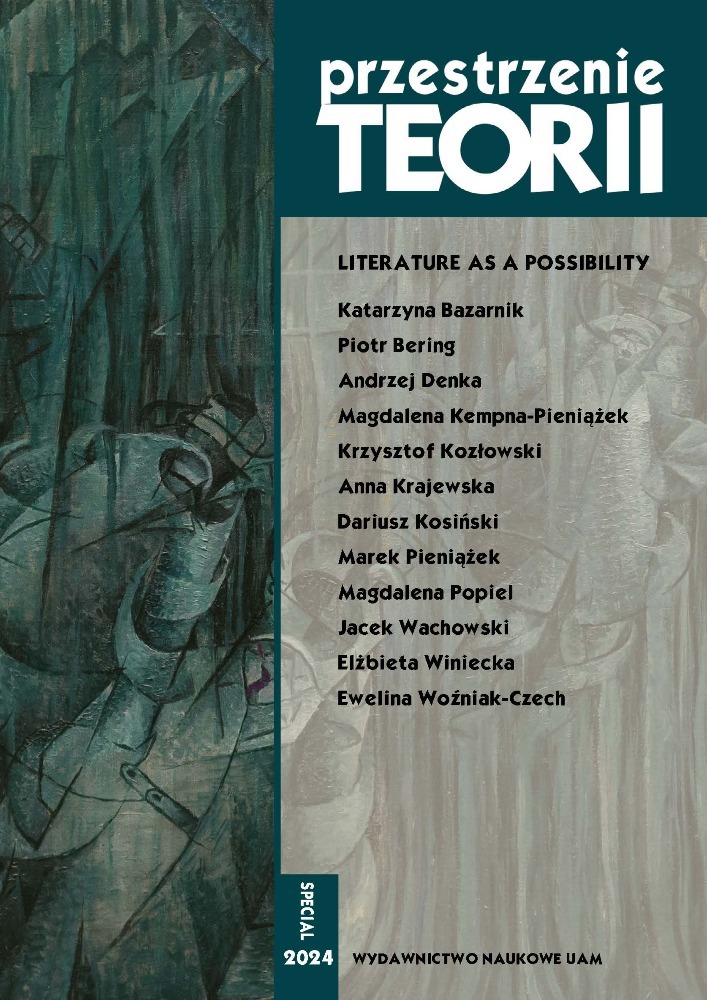Abstract
The article focuses on the specificity and functions of metaphors in the poetry of Radosław Jurczak, and more broadly in the work of the youngest poets, for whom life in the world of digital media and the prospect of the development of artificial intelligence is an important part of their formative experience. The paper uses the terms introduced by Mark Fisher for this purpose: the weird and the eerie. The analysis compares poetic devices in Jurczak’s poems with the concept of poetic language of the first avant-garde, pointing out the changes occurring in the poetics and aesthetics of the works, also focusing on figures relating to the technological sphere of modernity. The paper polemizes with the view expressed by Jerzy Jarzębski, who considers the phrase “artificial intelligence” to be a fashionable and harmful oxymoron that defines the pragmatic, reductionist worldview of its users. The article argues that the incorporation of terms that have the status of catachreses and over-lexicalized metaphors in everyday language into the language of poetry allows their creative potential and ambiguity to be recovered. Finally, the paper considers scaling as a characteristic feature of the new poetic imagination, which also requires readers to take a new approach to the language of the new poetry.
References
Balcerzan E., Fragmenty o Przybosiu [On Przyboś], “Akcent” 1987, no. 1.
Czarnocka M., Mazurek M., Metafory w nauce [Metaphors in Science], “Zagadnienia Naukoznawstwa” 2012, no. 1.
Derrida J., Widma Marksa. Stan długu, praca żałoby i nowa Międzynarodówka [Specters of Marx: The State of the Debt, the Work of Mourning and the New International], trans. T. Załuski, Warszawa 2016.
Fischer M., Dziwaczne i osobliwe [The Weird and the Eerie], trans. A. Karalus, Gdańsk 2024.
Harari Y.N., Harari Argues that AI Has Hacked the Operating System of Human Civilization, “The Economist”, April 28, 2023, https://www.economist.com/by-invitation/2023/04/28/yuval-noah-harari-argues-that-ai-has-hacked-the-operating-system-of-human-civilisation (accessed: 16.06.2024).
Jarzębski J., Sztuczna inteligencja jako metafora [Artificial Intelligence as a Metaphor], “Naukowy Przegląd Dziennikarski” 2020, no. 4.
Jurczak R., Pamięć zewnętrzna [External Memory], Łódź 2016.
Jurczak R., Zakłady holenderskie [Dutch Book], Stronie Śląskie 2020.
Kuśmierek M., Jak działa ChatGPT-4 i czy jest warty swojej ceny? [How Does ChatGPT-4 Work and Is It Worth Its Price?], https://spidersweb.pl/2023/03/gpt-4-jak-dziala.html (accessed: 10.12.2023).
Kwiatkowski J., Świat poetycki Juliana Przybosia [The Poetic World of Julian Przyboś], Warszawa 1972.
Mazurkiewicz-Sułkowska J., Słowiańska terminologia techniczna (na materiale polskim, rosyjskim i bułgarskim) [Slavic Technical Terminology on Polish, Russian and Bulgarian Materials], Łódź 2014. DOI: https://doi.org/10.18778/7969-306-1
Niedziński B., Izraelski filozof: sztuczna inteligencja zhakowała system operacyjny ludzkiej cywilizacji [Israeli Philosopher: AI Has Hacked the Operating System of the Human Civilization], https://www.pap.pl/aktualnosci/news%2C1572208%2Cizraelski-filozof-sztuczna-inteligencja-zhakowala-system-operacyjny?fbclid=IwAR0EbRd7e7N3csLR6s0GfQ8RiQO4JOb15oSCal54IBlb7Rh6eF2g26PVfyE (accessed: 16.06.2024).
Nycz R., Wiersz jest “jak raca”. Juliana Przybosia poetyka oświecenia a estetyka nowoczesna [A Poem Is Like a Firework: Julian Przyboś’s Poetics of Enlightement and Modern Aesthetics], [in:] R. Nycz, Literatura jako trop rzeczywistości. Poetyka epifanii w nowoczesnej literaturze polskiej [Literature as a Trope of Reality: Epiphany Poetics in the Modern Polish Literature], Kraków 2012.
Peiper T., Metafora teraźniejszości [The Metaphor of the Present Day], “Zwrotnica” 1922, no. 3.
Przyboś J., Idea rygoru [The Idea of Rigor], “Zwrotnica” 1927, no. 12.
Sandauer A., Zebrane pisma krytyczne [Collected Critical Essays], vol. 1, Warszawa 1981.
Searle J., Can Computers Think?, [in:] Philosophy of Mind: Classical and Contemporary Readings, ed. D.J. Chalmers, Oxford 2002.
Searle J., Minds, Brains & Science: The 1984 Reith Lectures, London 1984.
Skurys J., Przyszłość jest chmurą, przyszłość jest chwytem [The Future Is a Cloud, the Future Is a Literary Device], Biblioteka. Magazyn literacki, https://www.biuroliterackie.pl/biblioteka/recenzje/przyszlosc-jest-chmura-przyszlosc-jest-chwytem/ (accessed: 10.12.2023).
Turing A.M., I.-Computing Machinery And Intelligence, “Mind” 1950, vol. 59, iss. 236, pp. 433-460, https://academic.oup.com/mind/article/LIX/236/433/986238 (accessed: 2.09.2024). DOI: https://doi.org/10.1093/mind/LIX.236.433
Wittgenstein L., Tractatus logico-philosophicus, trans. B. Wolniewicz, Warszawa 1970.
License
Copyright (c) 2024 Elżbieta Winiecka

This work is licensed under a Creative Commons Attribution-NonCommercial-NoDerivatives 4.0 International License.
Authors
Authors of texts accepted for publication in Przestrzenie Teorii are required to complete, sign and return to the editor's office the Agreement for granting a royalty-free license to works with a commitment to grant a CC sub-license.
Under the agreement, the authors of texts published in Przestrzenie Teorii grant the Adam Mickiewicz University in Poznań a non-exclusive, royalty-free license and authorize the use of Attribution-NonCommercial-NoDerivatives 4.0 International (CC BY-NC-ND 4.0) Creative Commons sub-license.
The authors retain the right to continue the free disposal of the work.
Users
Interested Internet users are entitled to use works published in Przestrzenie Teorii since 2015, for non-commercial purposes only, under the following conditions:
- attribution - obligation to provide, together with the distributed work, information about the authorship, title, source (link to the original work, DOI) and the license itself.
- no derivatives - the work must be preserved in its original form, without the author's consent it is not possible to distribute the modified work, such as translations, publications, etc.
Copyrights are reserved for all texts published before 2015.
Miscellaneous
Adam Mickiewicz University in Poznań retains the right to magazines as a whole (layout, graphic form, title, cover design, logo etc.).

